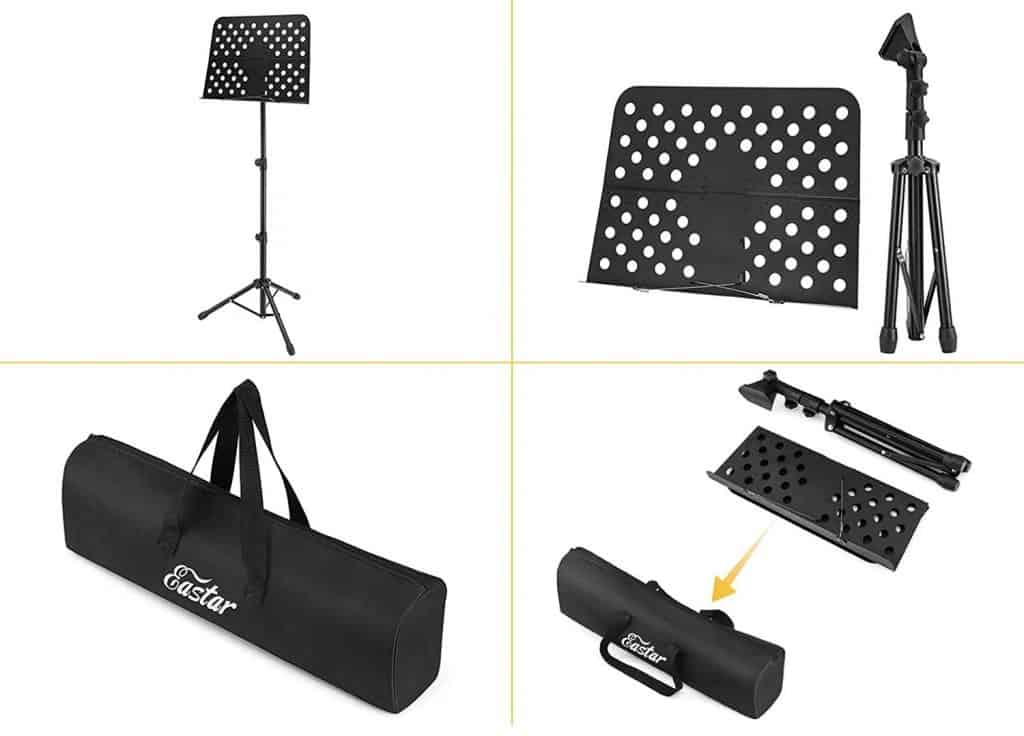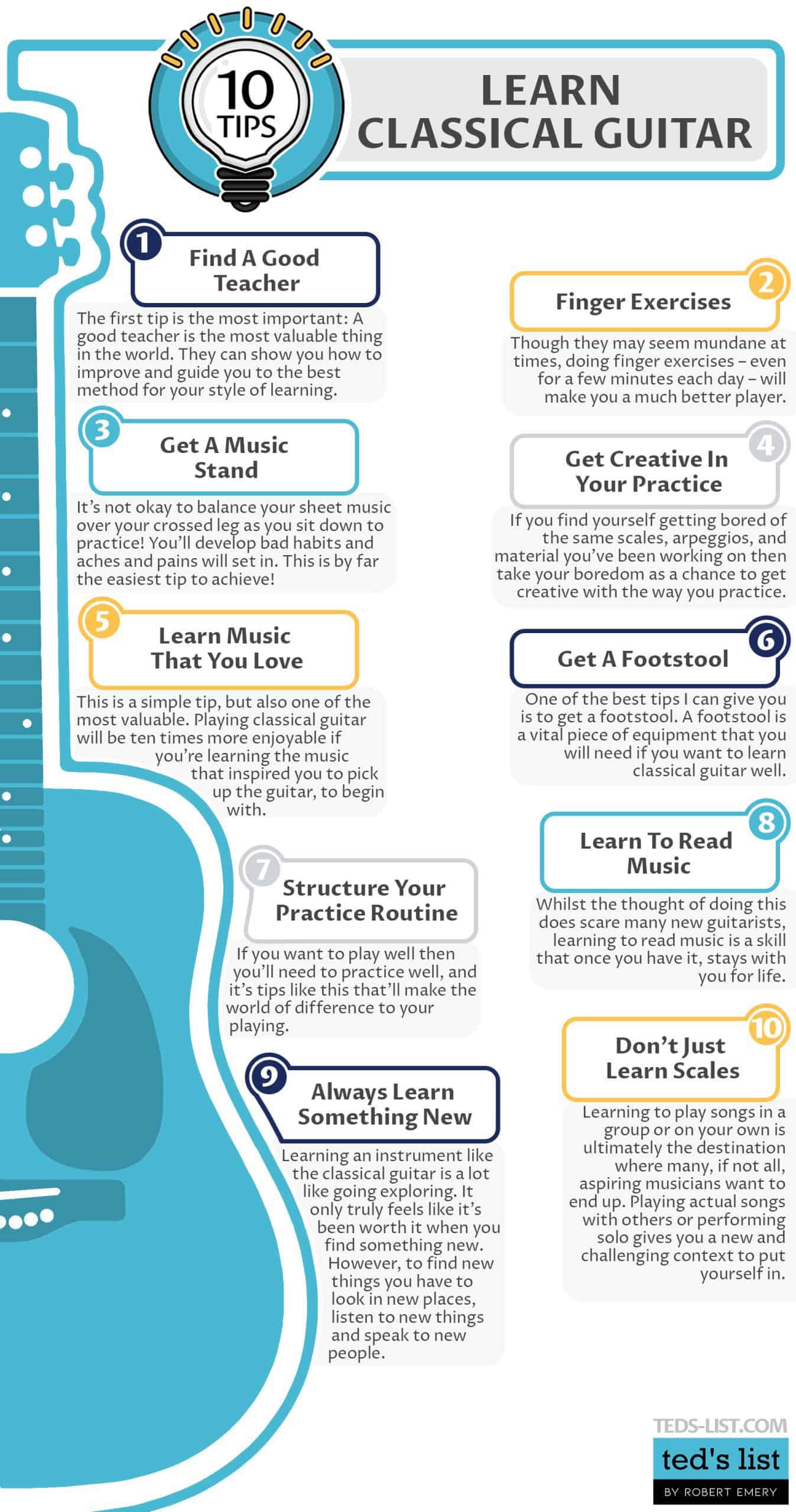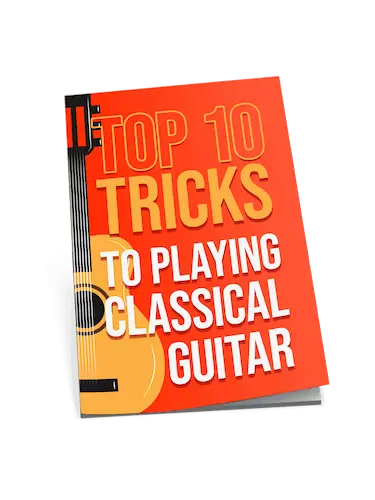**Classical guitar might seem tough, yet it stands as one of the most *beautiful* instruments to master.**
Classical guitarists, once they get over the beginner stage, become obsessed with their instrument. They love learning music, and their aim is to learn classical guitar as quickly as possible.
But what is the best way to get started?
How do you keep having fun whilst maintaining progress?
Well, it’s all about your practicing techniques. Classical guitar music isn’t the easiest music in the world to play, so it’s important to have a strong guitar method to start you off in the right direction.
So here is a list of 10 tips for learning classical guitar.
Find A Good Teacher
The first tip is the most important: A good teacher is the most valuable thing in the world. They can spot your weaknesses but most importantly, show you how to improve them. They will guide you to the best method book for your style of learning. So if you can afford it, get private lessons.
But how do you know when you’ve got a good tutor? There are so many to choose from!
Well, the best advice I can give, is to look for the simple things:
- Do you like the way they explain things to you?
- Do you understand them when they are teaching you complicated techniques?
- Are you making good progress with them?
- Do they inspire you?
- Do they give you simple tips that make the world of difference to your playing?
If you answered yes to most or all of these questions, then you’ve found a great tutor who works for you.
But are you still looking for that elusive person? Where do you go to find someone who can help you play classical guitar?
My first ‘port of call’ would be to find personal recommendations from your local area. Do some research on Facebook and Linkedin to see who your local teachers are, and what sort of support they have from their students.
Great teachers will usually have recommendations splurting out of the mouths of their pupils all over the place! They often have a Facebook group. And they will often have a waiting list. All of these things are a good sign that the teacher is worthwhile and in demand.
If this is the case, get on that waiting list, and ask for a trial lesson.
The key thing to remember about having classical guitar lessons is that nothing is set in stone. Nothing is forever. If you don’t get on with the teacher as much as you thought you would; just stop having lessons and find someone else. It’s as simple as that!
Finger Exercises
Though they may seem mundane at times, doing finger exercises – even for a few minutes each day – will make you a much better player. Your technique is the element of playing the classical guitar that’ll make or break you, and exercises are one of the best ways to develop this.
All good classical guitarists need to be able to get the most out of their hands and this means having a few weaknesses and technical blind spots as possible.
Think of finger exercises as being similar to general conditioning that athletes do.
Yes, you’re unlikely to ever play a piece of music that is a finger exercises from start to finish but that would be to miss the point of the exercises entirely. They are there to give you a general level of ability that you can then apply to the music you play.
Taking a 30-minute run each day will give you a decent level of general fitness, adding 10 minutes of finger exercises to your practice routine each day will make your playing smooth and consistent.
Something all classical guitar players should strive for.
And remember both your left hand and right hand need separate love and attention! They both require a different technique, so spend time on both hands. Equal opportunities strike again!
Get A Music Stand
It’s not okay to balance your sheet music over your crossed leg as you sit down to practice! You’ll develop bad habits and aches and pains will set in.
Getting a music stand is a simple thing to do, that’ll pay dividends down the line. Out of everything in this article, this is by far the easiest tip to achieve!
A decent music stand means no more awful posture when playing and trying to balance sheet music on your knee. But it also means you can have your music where you can best see, you can spread out multiple sheets so you don’t have awkward page turns and a good music stand is something you can easily take to a lesson, band practice, or performance.
Guitar playing is hard enough as it is, so don’t make it harder by having cheap equipment that breaks…
Personally, I always think it’s worth getting something that’s well built and that will last a long time. The cheaper foldable music stands are fine for when you need a transportable one for gigs; and if you need one of those, go for something like this model – but for learning at home, get something that won’t collapse every five minutes!
Yes, it may cost a little more initially but it will be such a worthwhile investment and many good music stands can last as long as ten years. For comparison, a poorly made one can break in a few weeks.
We recommend this model of music stand. It is reliable, has great reviews, and I have one myself and love it!
Get Creative In Your Practice
Practice doesn’t have to be just scales and endless arpeggios. But, whatever a practice session consists of, it does have to be done.
Every beginner guitarist needs to go through the rite of passage of struggling for a few months. It’s part of the learning process; and if that’s the stage you currently at, keep going! There is light at the end of the tunnel. Practice is the element that brings that light closer to you…
If you find yourself getting bored of the same material you’ve played over and over for the last few weeks and months then take your boredom as a chance to get creative with the way you practice.
Here are some examples.
- Could you write a short classical guitar piece with the scales you’ve learned?
- Can you use the scales and arpeggios you know to work out your favourite song?
- Do you have any you can practice and swap ideas with?
- Can you focus on your left hand for a day? Or focus on your right hand?
All these things will add a fresh perspective to the work that you’re doing and help you to see it in a new light.
Practicing is the key to becoming a good guitarist. All beginners struggle to get into a routine; but finding that routine is the element that will make everything work. Try 15 minutes every day, rather than an hour every three days. Short and sweet is often the route to success. And in each practice session, focus on a different element. These could consist of:
- Tone
- Chords
- Fingers
- Right-Hand Position
- Left-Hand Position
- General Technique
- Fingers
- Sound
This list is endless, and every technique will help your classical guitar playing no end!
Learn Music That You Love
This is a simple tip, but also one of the most valuable. Simply put, playing classical guitar will be ten times more enjoyable if you’re learning the music that inspired you to pick up the guitar, to begin with.
This isn’t something that’s just aimed at beginners either.
Many professionals – jazz musicians in particular – will dedicate a large part of their practice time to learning music that inspires them. This is especially good advice for beginners.
Not only does this increase each musician’s repertoire but it also keeps them inspired and makes such that the joy of playing music is never lost.
If all you do is play endless scales and arpeggios then it can feel a little soulless and you’ll likely feel that you’re not getting anywhere.
However, if you can pick up the guitar after a hard day at school or work and relax for the evening by playing through your favorite songs then you’ll associate playing the classical guitar with fun and enjoyment.
And this feeling will always keep you coming back to the guitar for more.
Get A Footstool
One of the best tips I can give you is to get a footstool. A footstool is a vital piece of equipment that you will need if you want to learn classical guitar well.
If you’ve ever watched a classical guitarist play on TV or YouTube then you’ve likely seen one of these without ever knowing what it is and why it’s so important.
First, let’s start with what a footstool is.
What is a footstool?
A footstool is a miniature platform that you rest one of your feet on as you play.
Now we’ve got that out of the way we can discuss why it’s so important.
One of the things that distinguish classical guitar from an acoustic and electric guitar is that the technique and body posture involved in playing classical guitar is totally different from the other two.
One foot (usually the opposite foot from your plucking hand) sits on the stool so that the guitar can rest over your raised leg at an angle whilst you play. This makes your posture better and makes it easier for your hands to play.
A good footstool isn’t expensive and when it comes to learning classical guitar it really is a must-have! That’s why I recommend (and use!) this particular footstool – Hercules FS100B. It’s popular with most guitarists, never breaks, and has a quality about it that makes you confident to put your body weight on it!
Structure Your Practice Routine
If you want to play well then you’ll need to practice well, and it’s tips like this that’ll make the world of difference to your playing. If you want to practice well, then you’ll need to know what to practice!
A well-structured practice routine will give you guidance and focus during those valuable practice hours. It will also make sure you don’t waste your time trying to figure out what to practice, checking Facebook, or just generally wasting time.
Firstly, switch off your phone (or at the very least, put it on DND).
Secondly, get yourself comfortable. Have your glass of water, your cup of tea (or whatever beverage you desire) ready at waiting.
Then, structure your practice routine. Sit down and tell yourself “today I’m going to work on my tone”. Or “I need to focus on practicing my left-hand position”. Or “My technique needs to improve, so I’m not going to play chords today until I work on getting my fingers more independent”.
It doesn’t really matter what it is, as long as it’s a conscious thought from you with a macro-goal.
Remember, macro goals are the way forward. Lots of mini things to aim for, and when you achieve them, you’ll get a sense of self-confidence and a boost in your efforts.
It’s often a good idea to allocate a certain amount of time to each thing you need to practice within your routine. The more you need to work on something – scales for example – then the more time you should allocate it.
One of the best ways to help you with your practicing is to video yourself. Not only can you play it back and check your technique, but you can also check you focused on achieving whatever goal you set yourself. Your progress will speed up. You’ll spot all the mistakes beginners often make. Your technique will get better, faster. You’ll produce a nicer sound. Oh, and did I say the speed of your progress will rocket you from a beginner to an intermediate player in no time!
Out of all these tips on how to learn classical guitar, this one is the thing that can make a massive difference fast.
Learn To Read Music
Just because these tips on learning the classical guitar are free, doesn’t mean they are easy! Another thing that sets classical guitar apart from the electric and acoustic guitar is that classical guitarists don’t use TAB. They only read notation.
So if you want to learn classical then you must get to grips with notation.
Whilst the thought of doing this does scare many new guitarists, learning to read music is a skill that once you have it, stays with you for life. Yes, it’s a steep learning curve. Yes, learning to read music is difficult. But it’s not impossible. Just treat it as a separate skill.
Learning the classical guitar, and learning to read music ARE separate skills. Of course, they are linked, but they require a different set of skills and a different way of thinking.
Watch a YouTube video about notation. Set aside a portion of every practicing session to improving your music reading.
Is classical guitar hard to learn? Yes, I know it’s hard, and as a beginner, it feels like a hurdle you’ll never be able to leap over. But be patient and stick with notation. It may feel slow going, especially when you compare yourself to those learning from TAB, but here’s the best thing about notation. It’s a much better system to learn because it makes you a better musician.
Notation teaches you about rhythm, duration, articulation, and pitch and TAB can only handle pitch.
Learning notation will also give you the ability to talk to any other instrumentalist that uses notation whereas TAB is only for guitar and bass players.
It’s a longer road to travel but it’s one of the most valuable skills you can learn as a classical guitarist!
Learning an instrument like the classical guitar is a lot like going exploring. It only truly feels like it’s been worth it when you find something new.
However, to find new things you have to look in new places, listen to new things and speak to new people.
A great way to do this is by engaging with the classical guitar community via a regular magazine, online forum or YouTube channel. Our Ted’s List Facebook VIP Group has a lot of guitarists that support each other; so come and join that.
A magazine, for example, will have new columns and tips for you to read each month and many of the writers give out small weekly lessons complete with new exercises to try and music to listen to.
Online forums will have debates between different guitar players on a wide range of topics. Watch out though. These can get pretty heated sometimes!
And a good YouTube channel will post new videos each week for you to work through.
Learning new things will broaden your horizons and keep you motivated to improve.
Don't Just Learn Scales
Don’t just learn scales, chords, arpeggios, and exercises – learn music.
This might sound like a contrary point. Especially after I’ve spent large portions of this article stressing the importance of scales, chords, arpeggios, and the like. But don’t get me wrong. I’m not trying to say those things are bad.
What I’m saying is they’re stepping stones to something bigger. Start playing new chords in your practice sessions.
To be able to play actual pieces of music.
Learning to play songs in a group or on your own is ultimately the destination where many, if not all, aspiring musicians want to end up.
Playing actual songs with others or performing solo gives you a new and challenging context to put yourself in. It’s a much harder test of your mettle but it’s also one that is far more rewarding in the long run.
You’ll learn the most by having this performance-based context to apply your hard-earned knowledge gained from hours of practice and you’ll have a great time entertaining your friends with the great songs you can play.
Learn classical guitar - top 10 tips
Summary
Now, do you have to follow all ten of these tips to learn the classical guitar effectively? No, of course not.
Like everything in life, moderation is key. These tips on how to start learning classical guitar are meant to help you create your own style of learning. Your own road map.
Don’t expect to become a professional overnight. The journey from being a beginner to a pro is a long one. If you enjoy the journey, you’ll end up staying on the road for longer. So try extra hard to enjoy the journey.
Find music you love.
Give yourself small goals which you can achieve with relative ease.
Remember that all beginners go through what you’re going through, so keep the faith, focus on having fun, try your best to be as musical as possible, and just enjoy playing incredible music.
Good luck!
P.S. If you’re looking for more tips, we have created a 21 Guitar Tips For Beginners article that you’ll enjoy!
Do you want to share this infographic on your site? Use this code...
FAQ's
The best way to learn classical guitar is by having one-to-one lessons. Nothing will ever beat a teacher, sitting in front of you, helping you learn how to play the classical guitar. As an alternative option, you could try online tutorials – but be careful. Make sure they are written and created by a professional who you can trust – like a Ted’s List author, who are all world-class players and writers.
It is hard to learn classical guitar. But then again, it’s also hard to learn any musical instrument. By the very nature of becoming a musician, the learning curve is steep at the start – but that doesn’t mean it’s impossible, or not worth it. Find a great set of tutorials, or grab some lessons, and you’ll be able to play classical guitar in no time.
You can learn classical guitar on your own – yes. Just like you could learn to build a house on your own from online tutorials. But does that mean you SHOULD do it? Ideally not! You’ll learn to play the classical guitar more efficiently if you can afford private lessons. You’ll get a better technique, and you’ll transition from a beginner to an early intermediate player quickly. But if you can’t afford those lessons, then use a free service like Ted’s List to help you with tutorials.
Classical guitar is harder to learn than acoustic guitar, for the very simple reason that there is a stricter ‘rule book’ to follow. Acoustic Guitar is all about enjoying strumming chords, and occasionally playing a single-line melody. Most people who play acoustic guitar don’t learn to read music. Classical guitar is all about playing from sheet music beautifully constructed pieces of music, and virtually no strumming. To find out more, look at Ted’s List.
Asking how long it takes to learn classical guitar, is a bit like asking how long it takes to learn a language. Do you ever stop learning? You should be able to become a proficient beginner in six months or so. But classical guitar playing is all about the journey, not the destination. You’ll be learning how to control your sound, learning techniques, perfecting your position on the instrument, and all the other basics that go with becoming a classical guitarist. To find out more, read our specific article from Ted’s List.
Yes, classical music can be played on an acoustic guitar. In fact, the classical guitar is a specific type of acoustic guitar that is often used to play classical music. Many classical pieces have been arranged or transcribed for guitar, and there is a rich repertoire of classical guitar music available to explore.
While it is possible to use a pick on a classical guitar, it is not the traditional playing style and may not produce the desired sound. Classical guitar playing typically involves using the fingers to pluck the strings, which allows for greater control and expression.














Didn’t even know that there was a classical guitar before this.
Well now you do James! If you want a top 10 tips for acoustic, look here.